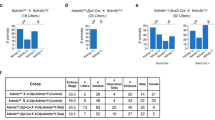Abstract
X-CHROMOSOME inactivation in mammals is a regulatory phenomenon whereby one of the two X chromosomes in female cells is genetically inactivated, resulting in dosage compensation for X-linked genes between males and females1. In both man and mouse, X-chromosome inactivation is thought to proceed from a single cis-acting switch region or inactivation centre (XlC/Xic)2–5. In the human, XIC has been mapped to band Xql3 (ref. 6) and in the mouse to band XD (ref. 7), and comparative mapping has shown that the XIC regions in the two species are syntenic8. The recently described human XIST gene maps to the XIC region6 and seems to be expressed only from the inactive X chromosome9. We report here that the mouse Xist gene maps to the Xic region of the mouse X chromosome and, using an interspecific Mus spretus/Mus musculus domesticus F1 hybrid mouse carrying the T(X; 16)16H translocation, show that Xist is exclusively expressed from the inactive X chromosome. Conservation between man and mouse of chromosomal position and unique expression exclusively from the inactive X chromosome lends support to the hypothesis that XIST and its mouse homologue are involved in X-chromosome inactivation.
This is a preview of subscription content, access via your institution
Access options
Subscribe to this journal
Receive 51 print issues and online access
$199.00 per year
only $3.90 per issue
Buy this article
- Purchase on Springer Link
- Instant access to full article PDF
Prices may be subject to local taxes which are calculated during checkout
Similar content being viewed by others
References
Lyon, M. F. Nature 190, 37–373 (1961).
Russell, L. B. Science 140, 976–978 (1963).
Cattanach, B. M. A. Rev. Genet 9, 1–18 (1975).
Mattei, M. G., Mattei, J. F., Vidal, I. & Giraud, F. Hum. Genet. 56, 401–408 (1981).
Therman, G., Sarto, G. E. & Patau, K., Chromosoma 44, 361–366 (1974).
Brown, C. J. et al. Nature 349, 82–84 (1991).
Rastan, S. & Robertson, E. J. J. Embryol. exp. Morph. 90, 379–388 (1985).
Keer, J. T. et al. Genomics 7, 566–572 (1990).
Brown, C. J. et al. Nature 349, 38–44 (1991).
Brockdorff, N. et al. Genomics 10, 17–22 (1991).
Cattanach, B. M., Rasberry, C. & Andrews, S. J. Mouse News Letter 83, 165 (1989).
Rastan, S. & Brown, S. D. M. Genet. Res. 56, 99–106 (1990).
Cattanach, B. M. & Papworth, D. Genet. Res. 38, 57–70 (1981).
Johnston, P. G. & Cattanach, B. M. Genet. Res. 37, 151–160 (1981).
Ashworth, A., Rastan, S., Lovell-Badge, R. & Kay, G. Nature (in the press).
Lyon, M. F., Searle, A. G., Ford, C. E. & Ohno, S. Cytogenetics 3, 306–323 (1964).
Brockdorff, N., Montague, M., Smith, S. & Rastan, S. Genomics 7, 573–578 (1990).
Cattanach, B. M. et al. Cytogenet. Cell Genet. (in the press).
Brockdorff, N., Kay, G., Cattanach, B. M. & Rastan, S. Mammalian Genome (in the press).
Chirgwin, J. M. et al. Biochemistry 18, 5294–5299 (1979).
Sambrook, J., Fritsch, E. F. & Maniatis, T. Molecular Cloning: A Laboratory Manual (Cold Spring Harbor Laboratory Press, New York 1989).
Minty, A. J. et al. J. biol. Chem. 256, 1008–1014 (1981).
Author information
Authors and Affiliations
Rights and permissions
About this article
Cite this article
Brockdorff, N., Ashworth, A., Kay, G. et al. Conservation of position and exclusive expression of mouse Xist from the inactive X chromosome. Nature 351, 329–331 (1991). https://doi.org/10.1038/351329a0
Received:
Accepted:
Issue Date:
DOI: https://doi.org/10.1038/351329a0
This article is cited by
-
Discovering therapeutic possibilities for polycystic ovary syndrome by targeting XIST and its associated ceRNA network through the analysis of transcriptome data
Scientific Reports (2024)
-
Gene regulation in time and space during X-chromosome inactivation
Nature Reviews Molecular Cell Biology (2022)
-
Regulatory non-coding RNAs: everything is possible, but what is important?
Nature Methods (2022)
-
Constitutive heterochromatin propagation contributes to the X chromosome inactivation
Chromosome Research (2022)
-
BAF complex-mediated chromatin relaxation is required for establishment of X chromosome inactivation
Nature Communications (2022)
Comments
By submitting a comment you agree to abide by our Terms and Community Guidelines. If you find something abusive or that does not comply with our terms or guidelines please flag it as inappropriate.



